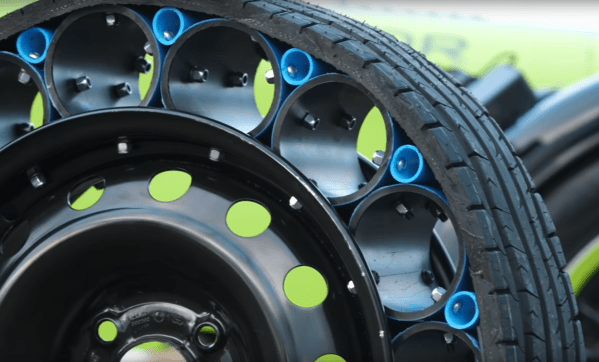Toyota is going through a bit of a Kodak moment right now, being that like the film giant they absolutely blundered the adoption of a revolutionary technology. In Kodak’s case it was the adoption of the digital camera which they nearly completely ignored; Toyota is now becoming similarly infamous for refusing to take part in the electric car boom, instead placing all of their faith in hybrid drivetrains and hydrogen fuel cell technologies. Whether or not Toyota can wake up in time to avoid a complete Kodak-style collapse remains to be seen, but they have been making some amazing claims about battery technology that is at least raising some eyebrows. Continue reading “Toyota Makes Grand Promises On Battery Tech”
vehicle48 Articles
Using Sonar To Measure Traffic Speeds
One of the most common ways of measuring the speed of a vehicle is by using radar, which typically involves generating radio waves, directing them at a moving vehicle, and measuring the various ways that they return to the device. This is a tried-and-true method, but can be expensive and technically complex. [GeeDub] wanted an easier way of measuring vehicles passing by his home, so he switched to using sonar instead to measure speeds based on the sounds the cars generate themselves.
The method he is using is similar to passive sonar in submarines, which can locate objects underwater based on the sounds they produce. After a false start attempting to measure Doppler shift, he switched to time correlation using two microphones, essentially using stereo audio input to detect subtle differences in arrival times of various sounds to detect the positions of passing vehicles. Doing this fast enough and extrapolating the data gathered, speed information can be calculated. For the data gathering and calculation, [GeeDub] is using a Raspberry Pi to help keep costs down, and some further configuration of the microphones and their power supplies were also needed to ensure quality audio was gathered.
With the system in place in a window, it detected around 9,000 vehicles over a three-day period. The software generates a normal distribution of vehicle speeds for this time, with the distribution centered on around 35 MPH, slightly above the posted speed limit of 30. As long as there’s a clear line of sight to the road using this system it’s just as effective as some other passive systems we’ve seen to measure vehicle speed. Of course, active speed measurement systems are not out of the realm of possibility if you’re willing to spend a little more.
Remote-Controlled Hypercar Slices Through Air
Almost all entry-level physics courses, and even some well into a degree program, will have the student make some assumptions in order to avoid some complex topics later on. Most commonly this is something to the effect of “ignore the effects of wind resistance” which can make an otherwise simple question in math several orders of magnitude more difficult. At some point, though, wind resistance can’t be ignored any more like when building this remote-controlled car designed for extremely high speeds.
[Indeterminate Design] has been working on this project for a while now, and it’s quite a bit beyond the design of most other RC cars we’ve seen before. The design took into account extreme aerodynamics to help the car generate not only the downforce needed to keep the tires in contact with the ground, but to keep the car stable in high-speed turns thanks to its custom 3D printed body. There is a suite of high-speed sensors on board as well which help control the vehicle including four-wheel independent torque vectoring, allowing for precise control of each wheel. During initial tests the car has demonstrated its ability to corner at 2.6 lateral G, a 250% increase in corning speed over the same car without the aid of aerodynamics.
We’ve linked the playlist to the entire build log above, but be sure to take a look at the video linked after the break which goes into detail about the car’s aerodynamic design specifically. [Indeterminate Design] notes that it’s still very early in the car’s development, but has already exceeded the original expectations for the build. There are also some scaled-up vehicles capable of transporting people which have gone to extremes in aerodynamic design to take a look at as well.
Continue reading “Remote-Controlled Hypercar Slices Through Air”
Security Vulnerabilities In Modern Cars Somehow Not Surprising
As the saying goes, there’s no lock that can’t be picked, much like there’s no networked computer that can’t be accessed. It’s usually a continual arms race between attackers and defenders — but for some modern passenger vehicles, which are essentially highly mobile computers now, the defenders seem to be asleep at the wheel. The computing systems that control these cars can be relatively easy to break into thanks to manufacturers’ insistence on using wireless technology to unlock or activate them.
This particular vulnerability involves the use of a piece of software called gattacker which exploits vulnerabilities in Bluetooth Low Energy (BLE), a common protocol not only for IoT devices but also to interface a driver’s smartphone or other wireless key with the vehicle’s security system. By using a man-in-the-middle attack the protocol between the phone and the car can be duplicated and the doors unlocked. Not only that, but this can be done without being physically close to the car as long as a network of some sort is available.
[Kevin2600] successfully performed these attacks on a Tesla Model 3 and a few other vehicles using the seven-year-old gattacker software and methods first discovered by security researcher [Martin Herfurt]. Some other vehicles seem to have patched these vulnerabilities as well, and [Kevin2600] didn’t have universal success with every vehicle, but it does remind us of some other vehicle-based attacks we’ve seen before.
DIY Airless Tires Work Surprisingly Well
Airless tires have been “a few years away” from production for decades now. They’re one of the automotive version of vaporware (at least those meant for passenger vehicles), always on the cusp of being produced but somehow never materializing. They have a number of perks over traditional air-filled tires in that they are immune to flats and punctures, and since there aren’t any airless tires available at the local tire shop, [Driven Media] decided to make and test their own.
The tires are surprisingly inexpensive to make. A few pieces of drainage tubing of varying diameters, cut to short lengths, and then bolted together with off-the-shelf hardware is all it takes, although they note that there was a tremendous amount of hardware needed to fasten all the pipe lengths together. With the structure in place they simply cut a tread off of a traditional tire and wrapped it around each of the four assemblies, then bolted them up to their Caterham street-legal race car for testing.
While the ride quality was notoriously (and unsurprisingly) rough and bumpy, the tires perform admirably under the circumstances and survive being driven fairly aggressively on a closed-circuit race course. For such a low price and simple parts list it’s shocking that a major tire manufacturer like Michelin hasn’t figured out how to successfully bring one to a light passenger car yet.
Thanks to [Itay] for the tip!
Bike On Over To The Campground
Like many of us, [Paul] enjoys occasionally hitching up his tow-behind camper and heading out to the wilderness to get away from it all at his favorite campsite. Unlike the vast majority of those who share his passion for the outdoors, though, [Paul] is hitching his camper up to a bicycle. Both the camper and the bike are custom built from the ground up, and this video shows us a little more details on [Paul]’s preferred mode of transportation.
While he is known for building custom vehicles of one sort or another, this latest one is a more traditional bicycle frame that he has modified only slightly to fit a recumbent-style seat and a small gas-powered motor. Even though the motor is decades old, it started right up and gives the power needed to pull the custom camper. [Paul] builds one-person campers like this out of corrugated plastic for durability and light weight, and this one is specifically designed for his size and sleeping style. It includes everything needed for a night under the stars, too, including a stove, storage compartments, and a few windows.
With the bike and camper combined weighing in at just over 200 pounds, the motor can be used as a pedal-assist device thanks to the clever engineering behind a front-wheel-drive pedal system on this bike. With all of that custom fabrication, [Paul] is free to head out to the wilderness without all the encumbrances (and high price) of traditional motor vehicle-based camping. For those curious about some of [Paul]’s other vehicle creations, take a look at this tiny speedboat for one.
RC Snowmobile Makes Tracks On Ice
With all the futuristic technology currently at our disposal, it seems a little bizarre that most passenger vehicles are essentially the same thing that they were a century ago. Four wheels, a motor, and some seats would appear to be a difficult formula to beat. But in the 3D printing world where rapid prototyping is the name of the game, some unique vehicle designs have been pushed out especially in the RC world. One of the latest comes to us from [RCLifeOn] in the form of a single-wheeled RC snowmobile.
While not a traditional snowmobile with tracks, this one does share some similarities. It has one drive wheel in the back printed with TPR for flexibility and it also includes studs all along its entire circumference to give it better traction on ice. There are runners in the front made from old ice skates which the vehicle uses for steering, and it’s all tied together with an RC controller and some lithium batteries to handle steering and driving the electric motor.
There were some design flaws in the first iteration of this vehicle, including a very large turning radius, a gearing setup with an unnecessarily high torque, and a frame that was too flexible for the chain drive. [RCLifeOn] was also testing this on a lake which looked like it was just about to revert to a liquid state which made for some interesting video segments of him retrieving the stuck vehicle with a tree branch and string. All in all, we are hopeful for a second revision in the future when some of these issues are hammered out and this one-of-a-kind vehicle can really rip across the frozen wastes not unlike this other interesting snowmobile from a decade ago.

















